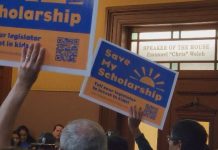Remote learning students lost more than half a year during COVID, significantly hindering their education progress, new data show.
by Emma Camp
It’s been four years since American schools shuttered, forcing millions of schoolchildren into months of online learning. While the decision was hailed as necessary to slow the spread of COVID-19 and protect teachers, the years since widespread school shutdowns have produced mounting evidence that pandemic closures led to massive learning losses for students, all without making a significant impact on COVID infections.
On Monday, The New York Times released an extended article combing over new data showing that post-COVID learning losses were directly related to how much time students spent in online school.
According to one study highlighted by the Times, school districts that spent the least amount of the 2020–21 school year in remote learning (between 0 percent and 10 percent online) experienced a significantly smaller drop in student scores than districts that spent almost all of the school year online. For the least online group, declines in third- and eighth-grade math scores indicated that students were 0.35 years behind where they should be, while the most online group had fallen back more than half a school year by 2022.
While other factors contributed to district-level learning loss, like student poverty, time spent in remote learning still had an incredibly large impact. Students in the poorest districts that stayed mostly in-person actually experienced less learning loss than students in the richest school districts that taught students mostly online.
Unsurprisingly, the students who suffered the most were poor students who experienced mostly remote learning. While mostly remote students in the richest school districts were only 0.15 school years behind their mostly in-person counterparts, mostly remote students in the poorest districts lost 0.25 years more than their peer districts who were mostly in-person. In all, poor, mostly online school districts saw their students fall nearly two-thirds of a school year behind in math scores.
Some of the last school districts to reopen were large, urban school districts with many poor students. However, the leadership in many of those districts hasn’t learned much in the face of mounting evidence that extended school closures hurt students without meaningfully reducing COVID infections.
“There’s no such thing as learning loss” United Teachers Los Angeles leader Cecily Myart-Cruz famously quipped in 2021, adding that “it’s OK that our babies may not have learned all their times tables. They learned resilience. They learned survival.”
“I do believe it was the right decision,” said Jerry T. Jordan, president of the Philadelphia Federation of Teachers, told the Times. Philadelphia schools didn’t fully return to in-person learning until August 2021. “It doesn’t matter what is going on in the building and how much people are learning if people are getting the virus and running the potential of dying.”
While it’s now been four years since schools first closed during COVID-19, the school year lost on online and hybrid learning has clearly had a lasting impact on American schoolchildren—one that is likely to echo for years to come.
Originally published by the Reason Foundation. Republished with permission.
For more School Reform News.










